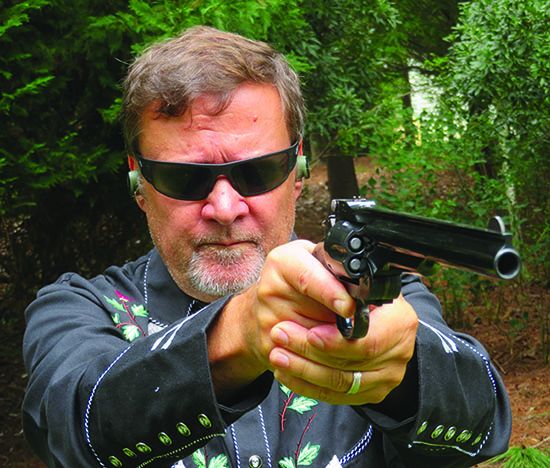Back in the Old West, there was a variety of six-shooters to choose from, but as years passed, many of these revolvers ended up in the bone orchard as new and modern models became available — just like today. Luckily, gun manufacturers resurrected some of these unique revolvers and are reproducing them today using stronger steel, better manufacturing techniques, and incorporating internal safeties. We acknowledge that these revolvers may not be Simon-pure compared to originals, but that doesn’t matter because these reproduction revolvers allow you to experience what it was like to wield these guns.
We looked at a total of four wheelguns, the first two of which were new sidearms chambered in 45 Colt, also widely called 45 Long Colt. (On Gun-Tests.com, see our New Shooter’s Guide, “45 Colt vs. 45 Long Colt vs. 45 ACP” for an explanation of these cartridges’ names.) Those two new guns were the Cimarron Firearms Co. Model No. 3, 1st Model American, and the Taylor’s & Company Cattleman Old Model Military Markings. Next month, we’ll look at a used Ruger Vaquero in 45 Long Colt, the old model that is no longer produced, and a Uberti 1872 Open Top Army CA910 in 44 Special.
These are single-action revolvers, so we did some thumb busting at the range and have plenty to say about what we experienced, but before we do that, here’s what we looked for in these guns. These Old West shooting irons were reviewed for accuracy, point of aim, trigger weight, ease of use, and sights. These revolvers would do well in Cowboy Action Shooting matches or plinking on a weekend.
Our first impression with these reproductions was that they had great balance and manageable recoil, and they required some hammer dexterity to make a long stretch of the thumb to cock them. Sights ranged from too tiny to see well, to large and very modern.
How We Tested
Our first order of business was accuracy testing using targets set at 15 yards and a range bag as rest. Things sped up when the targets were moved to 7 yards, and we fired the revolvers for speed using a two-hand grip and one-hand grip. Shooting hoglegs at speed really shows how well the shooter can manage recoil and how fast you can acquire the sights for follow-up shots. It also punches your cowboy card.
Naturally, we used some cowboy-powered ammo. Cowboy loads come in lower velocities for use in Cowboy Action Shooting competitions and offer less recoil. The are also a good option for plinking. In 45 Colt, we fired Hornady Cowboy loads with 255-grain round-nose flat-point (RNFP) bullets and Choice Ammunition with a 250-grain RNFP bullet. Also, we used a more modern Federal American Eagle load with a 225-grain jacketed soft point (JSP). It’s worth noting that these two revolvers are not compatible with +P ammo, only standard-velocity ammo.
Once we had a chance to fill our hands with these pistols, here’s what we learned about these reproduction equalizers.
Cimarron Firearms Co. Model No. 3 1st Model American CA8661
45 Long Colt
$1200
Gun Tests grade: B
The American has nice balance and a long sight radius due to the 8-inch barrel. The grip is a vertical shape, like a Colt Bisley. We would have liked the trigger-pull weight to be closer to 3 pounds or less. Accuracy was good, and it shot to point of aim.
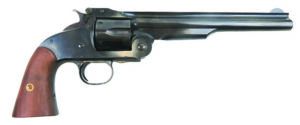
| Action Type | Revolver, single action, hammer fired |
| Overall Length | 13.5 in. |
| Barrel Length | 8.0 in. |
| Barrel Twist Rate | 1:16 in. RH |
| Sight Radius | 8.3 in. |
| Overall Height | 5 in. |
| Maximum Width | 1.6 in. |
| Weight Unloaded | 49.2 oz. |
| Weight Loaded | 54.4 oz. |
| Cylinder Gap | 0.010 in. |
| Capacity | 6 |
| Frame Finish | Blued |
| Barrel/Cylinder Finish | Blued |
| Frame Front Strap Height | 2.5 in. |
| Frame Back Strap Height | 3.2 in. |
| Grip | Smooth walnut, 2 piece |
| Grip Thickness (max) | 1.5 in. |
| Grip Circumference (max) | 5.7 in. |
| Front Sight | Fixed blade |
| Rear Sight | U-Notch |
| Hammer Cocking Effort | 5 lbs. |
| Trigger Pull Weight | 4.5 lbs. |
| Trigger Span | 2.6 in. |
| Safety | None |
| Warranty | 5 years to life |
| Telephone | (877) 749-4861 |
| Website | Cimarron-Firearms.com |
| Made In | Italy (Uberti) |
S&W licensed the rights on bored-through cylinders and introduced the No. 1 rimfire revolver back in 1859. In 1870, Smith & Wesson completely changed the combat-revolver landscape by offering the first big-bore-caliber revolver that used a centerfire metallic cartridge, the No. 3 in 44 S&W American. No other manufacturer could offer what the No. 3 brought to the table — fast reloads with metallic cartridges. The No. 3 American was very popular and was introduced years before the Colt Model 1873 Single Action Army. Wyatt and Virgil Earp supposedly used No. 3 revolvers at the OK Corral shoot-out due to the ability to reload the No. 3 guns fast.
The Cimarron version is produced by Uberti to Cimarron’s exacting specifications and is a reasonable replica of the original. New to the Cimarron American is the ability to fire 45 LC cartridges. The 44 American cartridge is shorter than the 45 LC. The modernized version also has a hammer-block safety. Pull the hammer back until you hear the first click, and a steel insert is placed between the hammer and the frame to prevent the gun from accidentally firing if dropped or the hammer banged.
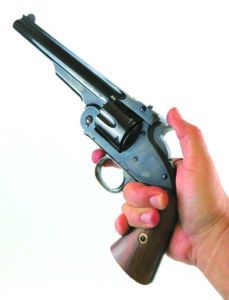
The American is a top-break revolver that allows the user to unlatch the barrel and cylinder and pivot them away from the frame, after which the ejector extracts the empty cases from the cylinder in one quick movement. The chambers can then be quickly loaded with cartridges.
Our sample wore a period-correct finish with color case hardening on the hammer, top latch, and trigger guard, and a deeply blued frame and barrel. The two-piece grips were smooth walnut and expertly fitted to the frame.
The American has a unique looking grip that is more vertical than sweeping, similar to a Colt Bisley revolver. The grip is small, thin, and comfortable to hold, with the weight of the revolver balancing above your trigger finger. The barrel is 8 inches long and gives the American a legendary presence. The stampings on the revolver are minimal and tasteful. The top of the barrel wears the Cimarron marking, and “U.S.” is stamped on the top strap.
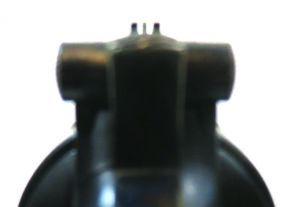
The American’s top-break design offers an advantage in speed to reload compared to a Colt-style SAA. To load the America, you need to cock the hammer to the first click to disengage the stub latch from a slot in the hammer. Pull up on the stub latch and rotate the barrel and cylinder away from the frame. Pivot the barrel/cylinder assembly as far as it will go so that the ejector snaps back into place, then load the chambers. We could manipulate the latch by readjusting our shooting-hand grip and pushing it open with our thumb, or we used our support hand to open the latch. The barrel/cylinder assembly easily pivoted on its own when empty, but when loaded, the shooter needed to give it an assist. You will need a flat-blade screwdriver to remove the cylinder for a thorough cleaning.
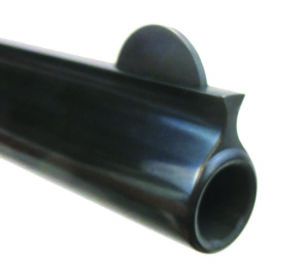
The fixed rear sight is built into the stub latch and looks like tiny football goal posts. Literally, the two small posts stick straight up. This is true to the original design. The front-sight blade is a half-moon shape. Not the most perfect sights for us to shoot surgically, but that didn’t stop us from shooting tiny groups.
The trigger is wide and smooth and broke heavy at 4.5 pounds. The trigger is wider and longer than a Colt-style SAA trigger.
Accuracy with the American was good, even though the sights were a 19th Century nightmare. The half-moon front sight is serviceable, but the rear sight seems like an afterthought. Two small posts that look like steel toothpicks protruding from the latch and the front post all look the same — small in size and color. The tightest five-shot group was with standard-velocity Federal American Eagle rounds, which measured 0.76 inches. The low-velocity cowboy loads from Hornady and Choice had best groups that measured 1.66 and 1.05 inches, respectively. On average, groups measured from a little over 1 inch to 2 inches.
When shooting for speed, we kept our eyes on the front blade. Rate of fire was a bit slower than with the Taylor’s, and the Cimarron’s five-shot groups averaged about 3 inches at 7 yards. The angle of the grip required us to hold the revolver high, plus it curls into the hand during recoil, so the shooter’s hand is almost under the hammer. That curl helps you get a thumb on the hammer spur to cock it, but your trigger finger ends up higher on the trigger and closer to the bottom of the frame. You lose leverage pressing the trigger that high up, and it makes the trigger pull seem even heavier. On the plus side, the high grip helps to mitigate muzzle flip, as does the weight of the revolver. Cocking the hammer with the support hand didn’t help to increase speed because there is not a lot of grip to hang onto. The trigger needed to be released to be reset after each shot, so you can’t keep the trigger pressed back and thumb the hammer. It took 5 pounds of effort to cock the pistol. The pointability of the revolver was good, and the long barrel offered a long sight radius.
Reloading was fast. We could load the cylinder two rounds at a time, making it as fast as loading a modern double-action revolver. Between the ejector and gravity, empties fell free from the revolver.
A potential issue is when ejecting a cylinder that contains empties and live rounds. The ejector could slip past the rim of the live round, allowing the live round to fall into the cylinder and the ejector resting on top of the cartridge rim rather than under it. The fix is to partially close the barrel and engage the ejector so it extends out from the cylinder, then turn the gun over so the round falls free.
Our Team Said: The Cimarron American is a legendary revolver and should be on your “guns to shoot” bucket list. If you are looking for speed in Cowboy Action Shooting competition, then pass on the American. If you want style and a fun-to-shoot gun, then the American is your huckleberry.
| 45 COLT RANGE DATA | ||
| Hornady Cowboy 255-grain RNFP | Taylor’s & Co. Cattleman | Cimarron Model No. 3 |
| Average Velocity | 773 fps | 744 fps |
| Muzzle Energy | 338 ft.-lbs. | 313 ft.-lbs. |
| Smallest Group | 0.99 in. | 1.66 in. |
| Average Group | 1.28 in. | 1.87 in. |
| Federal American Eagle 225-grain JSP | Taylor’s & Co. Cattleman | Cimarron Model No. 3 |
| Average Velocity | 955 fps | 838 fps |
| Muzzle Energy | 456 ft.-lbs. | 351 ft.-lbs. |
| Smallest Group | 2.09 in. | 0.76 in. |
| Average Group | 2.50 in. | 1.06 in. |
| Choice Ammunition 250-grain RNFP | Taylor’s & Co. Cattleman | Cimarron Model No. 3 |
| Average Velocity | 773 fps | 870 fps |
| Muzzle Energy | 338 ft.-lbs. | 420 ft.-lbs. |
| Smallest Group | 0.99 in. | 1.05 in. |
| Average Group | 1.28 in. | 1.51 in. |
To collect accuracy data, we fired five-shot groups from a bench using a rest. Distance: 15 yards with open sights. We recorded velocities using a ProChrono DLX digital chronograph set 10 feet from the muzzle.
Special thanks to Eastern Outfitters (EasternOutfitter.com) of Hampstead, NC, for their assistance.
Written and photographed by Robert Sadowski, using evaluations from Gun Tests Team members. GT



























